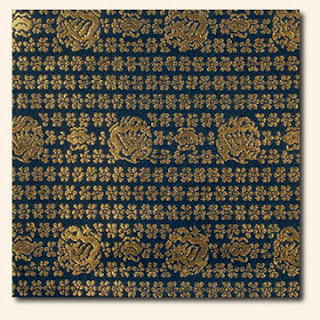Kinran(gold brocade) is considered the most gorgeous of the meibutsu-gire.
The first syllable of the word, kin, means "gold". the second, ran, refers to cloth that
was attached to the hem of a Buddhist cloak to strengthen it. Kinran has a ground wave of twill and weft patterns woven with either gold thread
or threadlike strips of gilded paper. Kinran was first made in China (known as Zhijin) during the Song Dynasty. It came to Japan through Sino-
Japanese trade at the end of the
Fujiwara and Kamakura periods, in form of ceremonial robes for Zen monks. Kinran began to be made in
Japan during the Momoyama period.
Below are some of the more well know kinran fabrics and patterns:
 |
| Futari Shizuka Kinran |
The name of this fabric comes from a Noh play called Futari Shizuka.
It is said that Ashikaga Yoshimasa shogun (1436-1490) performed this
particular play wearing a costume made of Futari Shizuka Kinran fabric.
Late Sung period - early Ming period.
 |
| Daito Kinran |
Daito kinran has a design of auspicious clouds. Daito kinran is popularly believed to be the fabric used in the surplice of
Daito Kokushi, the founder of Daitokuji (temple) in Kyoto, Sung period.
 |
|
| Osaka Kinran |
Osaka kinran is named after the shifuku used
with the Osaka Marutsubo chaire, from the Ming period.
 |
| Wakuda-de Kinran |
Wakuda kinran has a design of waterfowl in a lotus pond. Named for the owner of the fabric, from the Ming dynasty.
 |
| Shippo Setsugekka Kinran |
Shippo Setsugeka Kinran is a design of interlocking rings, with snowflakes, moon and flowers, favored by the Urasenke14th Generation Grand Tea Master Tantansai.
 |
| Hariya Kinran |
Hariya Kinran was named after the shifuku used
with the Hariya Katatsuki chaire owned by Hariya Soshum. Also called fish scale pattern.
 |
| Itoya Kinran |
Itoya is a design of jeweled wheels on a basket weave background. It is often woven as a futusu, or double weave fabric where the opposite colors appear on the reverse side. Where blue appears on one side of the cloth, yellow shows on the other and between them a pocket is created. Futsu weave is named for "breeze funnel" and derives from the empty space between the two faces of the fabric. If this were woven with gold thread it is "Itoya futsu kinran." The fabric name comes from the cloth owned by Itoya Ryotei, who lived in Kyoto in the 16th century. This fabric was made into a shifuku for the chaire named "Sogo nasu." This fabric was first made in China, probably, Ming
dinasty around 1573-1619.
 |
| Hanausagi Kinran |
 |
| Hanausagi Kinran |
 |
| Chaji Hanausagi Kinran |
 |
| Moegiji Hanausagi Kinran |
 |
| Suminokura Kinran |
The previous five fabrics are variations of a cute rabbit standing on its hind legs looking back at some blossoming trees. The last one is named Suminokura kinran for the wealthy Kyoto merchant Suminokura Ryoi, who was particularly fond of that kind of design, the difference is that the pattern is bigger than Hanausagi Kinran.
There are many other famously named kinran fabrics, but you can begin to recognize these fabrics in your study when the guests ask about shifuku kereji.
*Fabric photos courtesy of
Kitamura Tokusai Fukusaten Co., Ltd., Kyoto, Japan.via the now closed website Tea Hyakka..












No comments:
Post a Comment